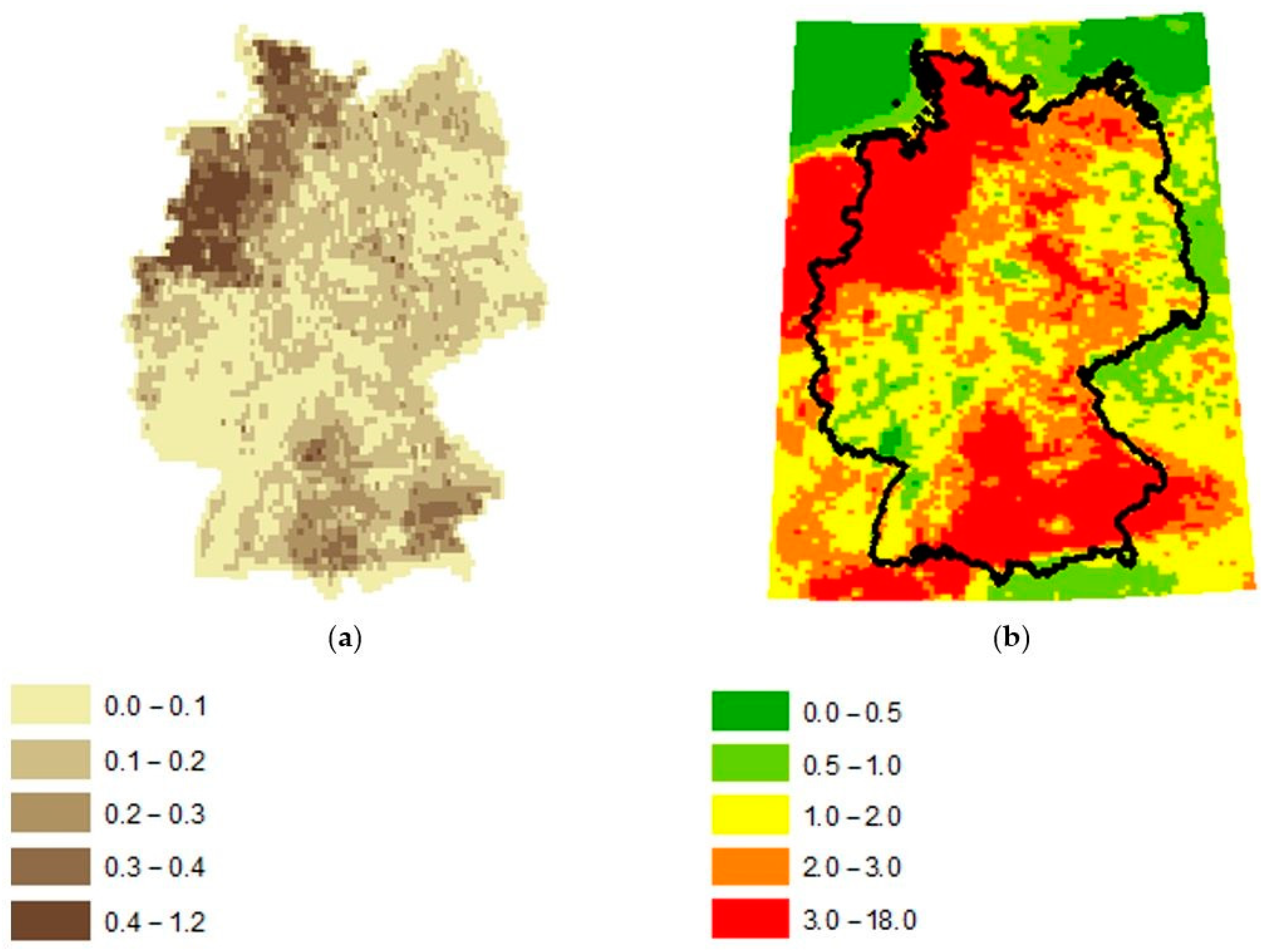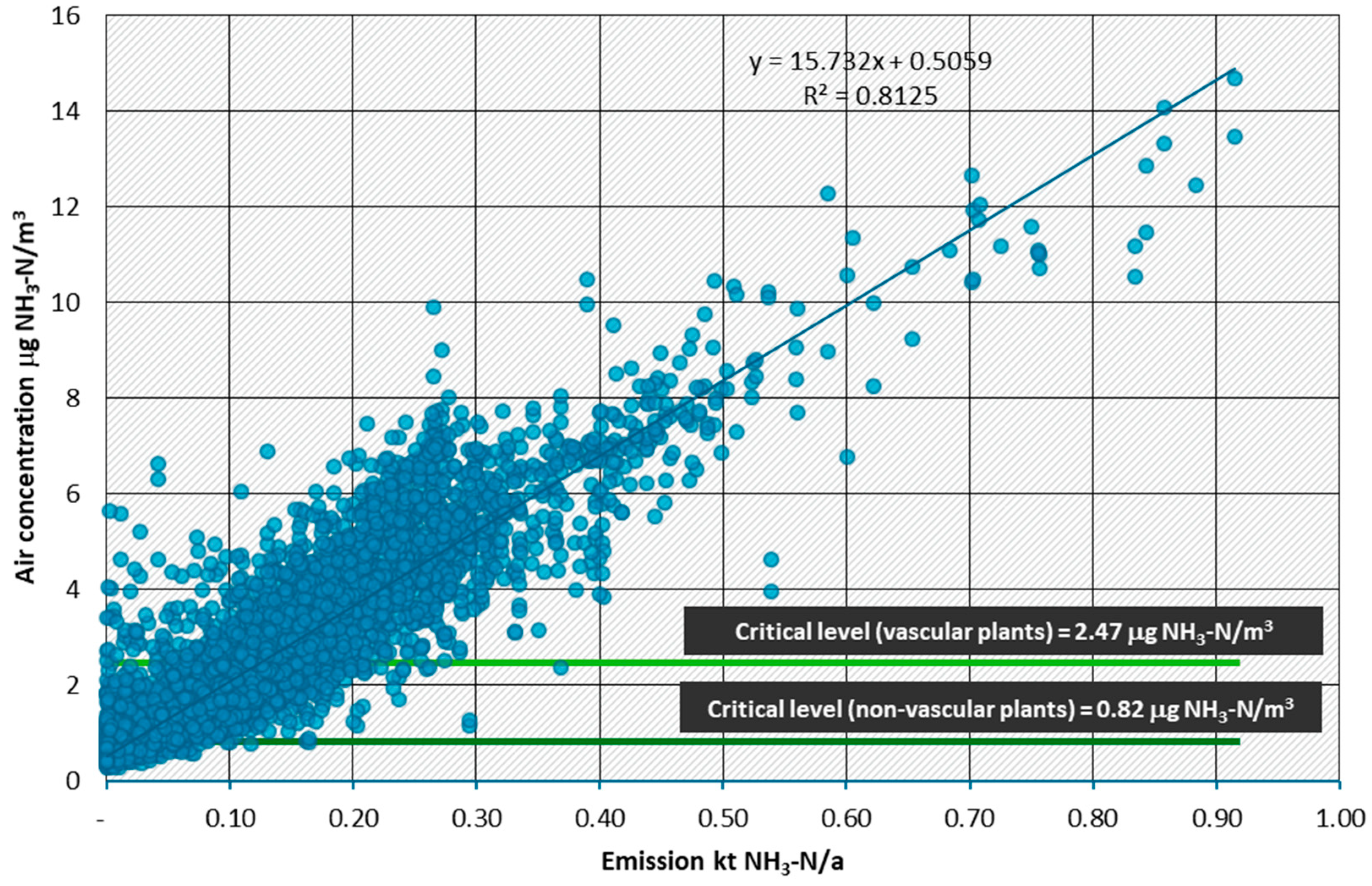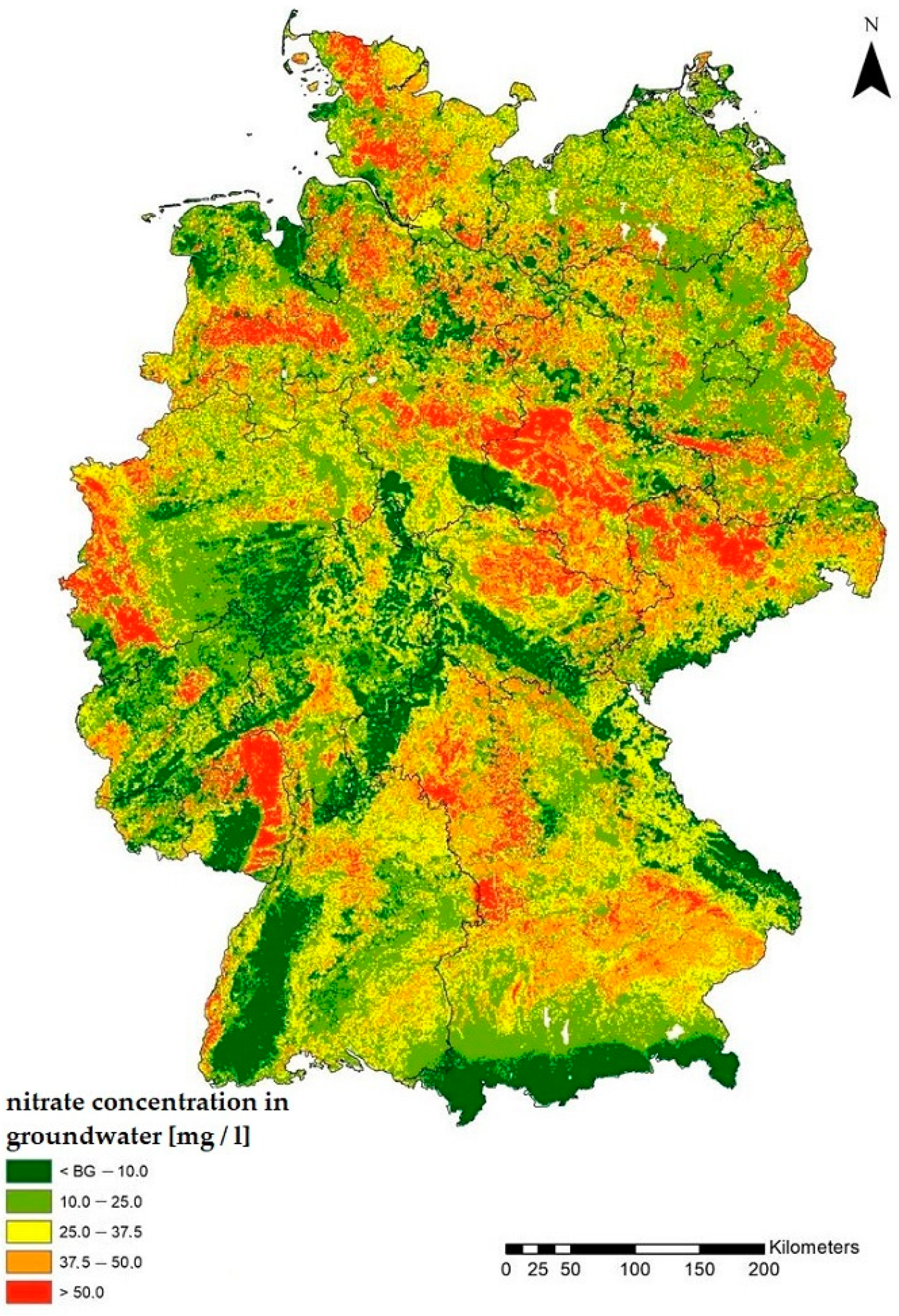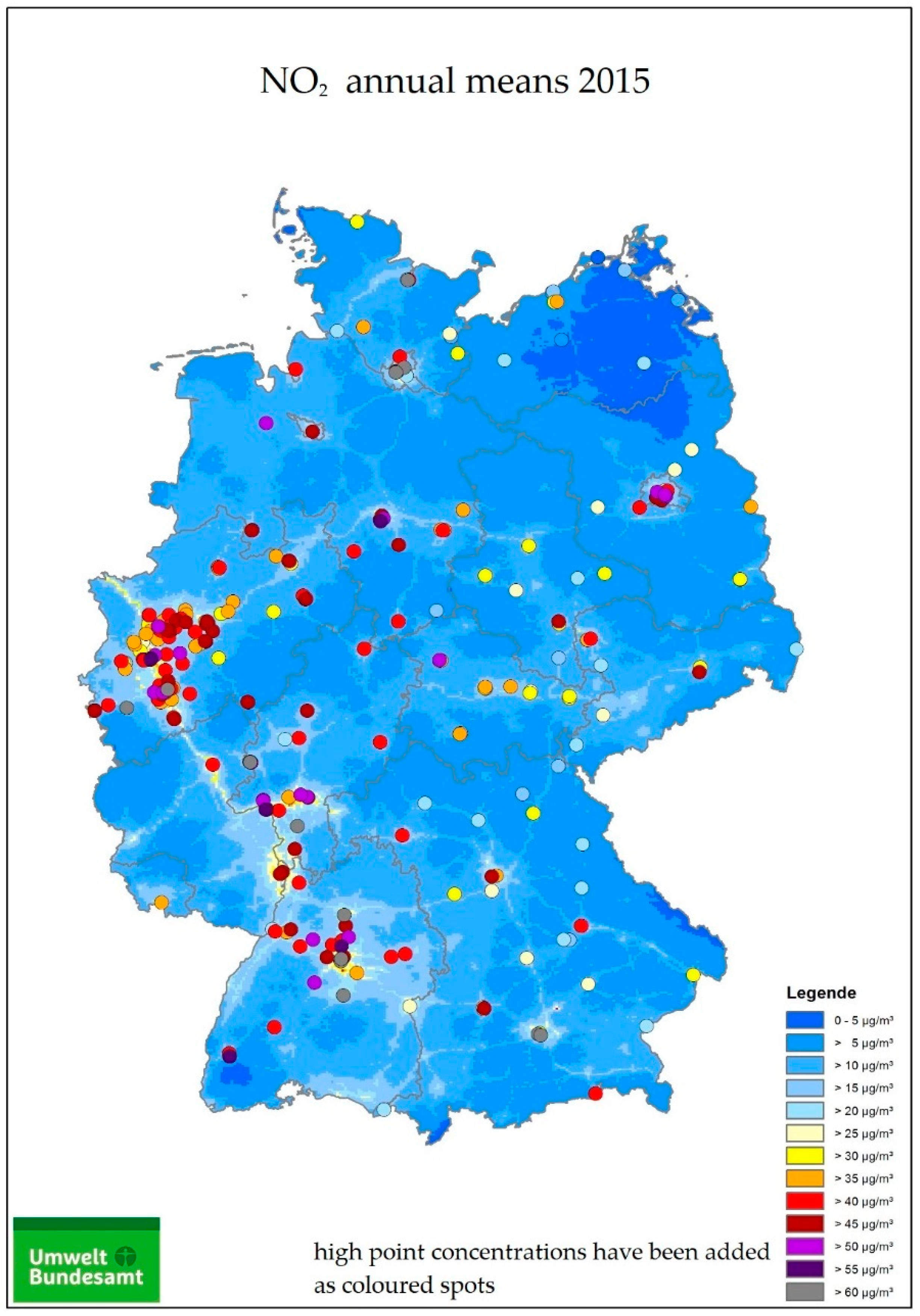A National Nitrogen Target for Germany
Abstract
:1. Introduction
2. Materials and Methods
2.1. Vegetation Affected by NH3-Concentration
2.2. Terrestrial Ecosystems Affected by Eutrophication
2.3. Surface Water Quality
2.4. Groundwater Quality Affected by Nitrate Concentration
2.5. Nitrous Oxide Emissions Affecting Climate Change
2.6. Human Health Affected by NO2 Concentration
3. Results
3.1. Vegetation Affected by NH3 Concentration
3.2. Terrestrial Ecosystems Affected by Eutrophication
3.3. Surface Water Quality
3.4. Groundwater Quality Affected by Nitrate Concentration
3.5. Nitrous Oxide Emissions Affecting Climate Change
3.6. Human Health Affected by NO2 Concentration
3.7. Summary of the Results
4. Discussion
5. Conclusions
Author Contributions
Funding
Institutional Review Board Statement
Informed Consent Statement
Data Availability Statement
Acknowledgments
Conflicts of Interest
References
- Fowler, D.; Coyle, M.; Skiba, U.; Sutton, M.A.; Cape, J.N.; Reis, S.; Sheppard, L.J.; Jenkins, A.; Grizzetti, B.; Galloway, J.N.; et al. The global nitrogen cycle in the twenty-first century. Philos. Trans. R. Soc. B Biol. Sci. 2013, 368, 20130164. [Google Scholar] [CrossRef] [PubMed]
- Erisman, J.W.; Sutton, M.A.; Galloway, J.N.; Klimont, Z.; Winiwarter, W. How a century of ammonia synthesis changed the world. Nat. Geosci. 2008, 1, 636–639. [Google Scholar] [CrossRef]
- Galloway, J.N.; Leach, A.M.; Bleeker, A.; Erisman, J.W. A chronology of human understanding of the nitrogen cycle. Philos. Trans. R. Soc. B Biol. Sci. 2013, 368, 20130120. [Google Scholar] [CrossRef] [PubMed] [Green Version]
- Erisman, J.W.; Galloway, J.N.; Seitzinger, S.; Bleeker, A.; Dise, N.B.; Petrescu, A.M.R.; Leach, A.M.; De Vries, W. Consequences of human modification of the global nitrogen cycle. Philos. Trans. R. Soc. B Biol. Sci. 2013, 368, 20130116. [Google Scholar] [CrossRef] [Green Version]
- Sutton, M.A.; Bleeker, A.; Howard, C.M.; Bekunda, M.; Grizzetti, B.; de Vries, W.; van Grinsven, H.J.M.; Abrol, Y.P.; Adhya, T.K.; Billen, G.; et al. Our Nutrient World: The Challenge to Produce More Food and Energy with Less Pollution; On Behalf of the Global Partnership on Nutrient Management and the International Nitrogen Initiative; Centre for Ecology and Hydrology: Edinburgh, UK, 2013. [Google Scholar]
- OECD. Human Acceleration of the Nitrogen Cycle: Managing Risks and Uncertainty; OECD Publishing: Paris, France, 2018. [CrossRef]
- UNEP. Frontiers 2018/19–Emerging Issues of Environmental Concern. 2019. Available online: https://www.unenvironment.org/resources/frontiers-201819-emerging-issues-environmental-concern (accessed on 29 November 2020).
- Rockström, J.; Steffen, W.; Noone, K.; Persson, Å.; Chapin, F.S., III; Lambin, E.; Lenton, T.M.; Scheffer, M.; Folke, C.; Schellnhuber, H.J.; et al. Planetary boundaries: Exploring the safe operating space for humanity. Ecol. Soc. 2009, 14, 32. [Google Scholar] [CrossRef]
- Steffen, W.; Richardson, K.; Rockström, J.; Cornell, S.E.; Fetzer, I.; Bennett, E.M.; Biggs, R.; Carpenter, S.R.; De Vries, W.; De Wit, C.A.; et al. Planetary boundaries: Guiding human development on a changing planet. Science Express 2015, 347, 1259855. [Google Scholar] [CrossRef] [Green Version]
- De Vries, W.; Kros, H.; Kroeze, C.; Seitzinger, S.P. Assessing planetary and regional nitrogen boundaries related to food security and adverse environmental impacts. Curr. Opin. Environ. Sustain. 2013, 5, 392–402. [Google Scholar] [CrossRef]
- Abrol, Y.P.; Adhya, T.K.; Aneja, V.P.; Raghuram, N.; Pathak, H.; Kulshrestha, U.; Sharma, C.; Singh, B. The Indian Nitrogen Assessment: Sources of Reactive Nitrogen, Environmental and Climate Effects, Management Options, and Policies; Elsevier: Duxford, UK, 2017. [Google Scholar]
- Tomich, T.P.; Brodt, S.B.; Dahlgren, R.A.; Scow, K.M. The California Nitrogen Assessment–Challenges and Solutions for People, Agriculture, and the Environment; University of California Press: Oakland, CA, USA, 2016. [Google Scholar] [CrossRef]
- Sutton, M.A.; Howard, C.M.; Erisman, J.W.; Billen, G.; Bleeker, A.; Grennfelt, P.; van Grinsven, H.; Grizetti, B. The European Nitrogen Assessment: Sources, Effects and Policy Perspectives; Cambridge University Press: Cambridge, NY, USA, 2011. [Google Scholar] [CrossRef]
- Umweltbundesamt. Reactive Nitrogen in Germany–Causes and Effects–Measures and Recommendations; Geupel, M., Frommer, J., Eds.; Umweltbundesamt: Dessau-Roßlau, Germany, 2015.
- Bach, M.; Häußermann, U.; Klement, L.; Knoll, L.; Breuer, L.; Weber, T.; Fuchs, S.; Heldstab, J.; Reutimann, J.; Schäppi, B. Reactive Nitrogen Flows in Germany 2010–2014 (DESTINO Report 2); Geupel, M., Ed.; Umweltbundesamt: Dessau-Roßlau, Germany, 2020.
- European Commission. Infringement Number 20132199 for Nitrate Directive–Germany. 2019. Available online: https://ec.europa.eu/atwork/applying-eu-law/infringements-proceedings/infringement_decisions (accessed on 21 November 2020).
- European Commission. Infringement Number 20152073 for Air Quality Directive–Germany. 2018. Available online: https://ec.europa.eu/atwork/applying-eu-law/infringements-proceedings/infringement_decisions (accessed on 21 November 2020).
- BMU–Federal Ministry for the Environment. Nitrogen Input in the Biosphere–First Nitrogen Report from the Federal Government; Federal Ministry for the Environment: Berlin, Germany, 2017.
- IPCC. Global Warming of 1.5 °C; An IPCC Special Report on the Impacts of Global Warming of 1.5 °C above Pre-Industrial Levels and Related Global Greenhouse Gas Emission Pathways, in the Context of Strengthening the Global Response to the Threat of Climate Change, Sustainable Development, and Efforts to Eradicate Poverty; Masson-Delmotte, V., Zhai, P., Pörtner, H.-O., Roberts, D., Skea, J., Shukla, P.R., Pirani, A., Moufouma-Okia, W., Péan, C., Pidcock, R., et al., Eds.; Intergovernmental Panel on Climate Change: Geneva, Switzerland, 2018; in press.
- Salomon, M.; Schmid, E.; Volkens, A.; Hey, C.; Holm-Müller, K.; Foth, H. Towards an integrated nitrogen strategy for Germany. Environ. Sci. Policy 2016, 55, 158–166. [Google Scholar] [CrossRef]
- SRU–German Advisory Council on the Environment. Nitrogen: Strategies for Resolving an Urgent Environmental Problem; Faulstich, M., Holm-Muller, K., Bradke, H., Calliess, C., Foth, H., Niekisch, M., Schreurs, M., Eds.; German Advisory Council on the Environment: Berlin, Germany, 2015. [Google Scholar]
- ICP Vegetation. Convention on Long-Range Transboundary Air Pollution (CLRTAP) Mapping critical levels for vegetation, Chapter 3. In Manual on Methodologies and Criteria for Modelling and Mapping Critical Loads and Levels and Air Pollution Effects, Risks and Trends; German Environment Agency: Dessau, Germany, 2017; Available online: https://www.umweltbundesamt.de/sites/default/files/medien/4292/dokumente/ch3-mapman-2017-10.pdf (accessed on 29 November 2020).
- European Commission. A Clean Air Programme for Europe–COM 2013; 918 final eds. European Commission; European Commission: Brussels, Belgium, 2013.
- European Union: Directive (EU) 2016/2284 of the European Parliament and of the Council of 14 December 2016 on the Reduction of National Emissions of Certain Atmospheric Pollutants, Amending Directive 2003/35/EC and Repealing Directive 2001/81/EC, European Union, 2016/2284; European Commission: Brussels, Belgium, 2016; Available online: http://data.europa.eu/eli/dir/2016/2284/oj (accessed on 29 November 2020).
- Bundesregierung: Ordinance on the Protection of Surface Waters (Oberflächengewässerverordnung–Verordnung zum Schutz der Oberflächengewässer) Bundesministeriums der Justiz und für Verbraucherschutz, BGBl. I S. 1373 vom 20. Juni 2016, 2016, Berlin. Available online: http://www.gesetze-im-internet.de/ogewv_2016/ (accessed on 29 November 2020).
- European Council: Council Directive of 12 December 1991 Concerning the Protection of Waters against Pollution Caused by Nitrates from Agricultural Sources European Council, 91/676/EEC, 1991, Brussels. Available online: http://data.europa.eu/eli/dir/1991/676/2008-12-11 (accessed on 29 November 2020).
- BMU–Bundesministerium für Umwelt Naturschutz und Reaktorsicherheit. Climate Action Plan 2050–Principles and Goals of the German Government’s Climate Policy; Bundesministerium für Umwelt Naturschutz und Reaktorsicherheit (BMU): Berlin, Germany, 2016.
- World Health Organization. Review of Evidence on Health Aspects of Air Pollution–REVIHAAP Project: Final Technical Report; World Health Organization: Geneva, Switzerland, 2013.
- Schrader, F.; Brümmer, C. Land use specific ammonia deposition velocities: A review of recent studies (2004–2013). Waterairsoil Pollut. 2014, 225, 1–12. [Google Scholar] [CrossRef] [PubMed] [Green Version]
- Umweltbundesamt: German Informative Inventory Report 2017 (IIR 2017). Available online: https://iir-de-17.wikidot.com/ (accessed on 21 November 2020).
- Camargo, J.A.; Alonso, Á. Ecological and toxicological effects of inorganic nitrogen pollution in aquatic ecosystems: A global assessment. Environ. Int. 2006, 32, 831–849. [Google Scholar] [CrossRef] [PubMed]
- Kolzau, S.; Wiedner, C.; Rücker, J.; Köhler, J.; Köhler, A.; Dolman, A.M. Seasonal patterns of nitrogen and phosphorus limitation in four German lakes and the predictability of limitation status from ambient nutrient concentrations. PLoS ONE 2014, 9, e96065. [Google Scholar] [CrossRef] [PubMed] [Green Version]
- LAWA. Associations of the River Basins to North-and Baltic Sea Nitrogen Reduction Targets of the German River Basins Association for the North-and Baltic Sea, 56. In Proceedings of the “Surface Water Board” of the Bund/Länderarbeitsgemeinschaft Wasser, Item 4.4.3, Integrated Nitrogen Strategy of the Federal Government, Wernigerode, Germany, 12–13 June 2018. [Google Scholar]
- Heldstab, J.; Schäppi, B.; Reutimann, J.; Bach, M.; Häußermann, U.; Knoll, L.; Klement, L.; Breuer, L.; Fuchs, S.; Weber, T. Integrated Nitrogen Indicator, National Nitrogen Target and the Current Situation in Germany (DESTINO Report 1); Geupel, M., Ed.; Umweltbundesamt: Dessau-Roßlau, Germany, 2020.
- Häußermann, U.; Klement, L.; Breuer, L.; Ullrich, A.; Wechsung, G.; Bach, M. Nitrogen soil surface budgets for districts in Germany 1995 to 2017. Environ. Sci. Eur. 2020, 32, 1–14. [Google Scholar] [CrossRef]
- UNFCCC CRF DEU Submission 2017 Reported by Umweltbundesamt. German Environment Agency. 2017. Available online: http://unfccc.int/files/national_reports/annex_i_ghg_inventories/national_inventories_submissions/application/zip/deu-2017-crf-11apr17.zip (accessed on 7 July 2017).
- European Union: Directive 2008/50/EC on Ambient Air Quality and Cleaner Air for Europe, European Union, 2008/50/EC, 2008, Brussels. Available online: https://eur-lex.europa.eu/legal-content/EN/ALL/?uri=CELEX%3A32008L0050 (accessed on 29 November 2020).
- Henne, S.; Brunner, D.; Folini, D.; Solberg, S.; Klausen, J.; Buchmann, B. Assessment of parameters describing representativeness of air quality in-situ measurement sites. Atmos. Chem. Phys. Discuss. 2009, 9, 20019–20062. [Google Scholar] [CrossRef]
- Rattigan, O.; Carpenter, A.; Civerolo, K.; Felton, H. Pollutant measurements at near road and urban background sites in New York, USA. Atmos. Pollut. Res. 2020, 11, 859–870. [Google Scholar] [CrossRef]
- Stern, R.; Kerschbaumer, A.; Reimer, E. Description of the Chemical Transport Model ’REM-CALGRID; Freie Universität Berlin: Berlin, Germany, 2009. [Google Scholar]
- Umweltbundesamt. German Air Quality Data of the Federal States and the German Environment Agency; Feigenspan, S., Ed.; 2017. Available online: https://www.umweltbundesamt.de/en/data/air/air-data, personal communication (accessed on 30 May 2017).
- Umweltbundesamt. Map Server for Annual Data on Air Quality of the German Environment Agency; Feigenspan, S., Ed.; 2018. Available online: http://gis.uba.de/Website/luft/index.html (accessed on 31 August 2018).
- International Institute for Applied Systems Analysis (IIASA). The Final Policy Scenarios of the EU Clean Air Policy Package; TSAP Report #11; Amann, M., Ed.; IIASA: Laxenburg, Austria, 2014. [Google Scholar]
- de Vries, W.; Hettelingh, J.-P.; Posch, M. Critical Loads and Dynamic Risk Assessments. Nitrogen, Acidity and Metals in Terrestrial and Aquatic Ecosystems; Springer Science+Business Media: Dordrecht, The Netherlands, 2015. [Google Scholar] [CrossRef]
- BMU–Federal Ministry for the Environment: Nationales Luftreinhalteprogramm der Bundesrepublik Deutschland, Bundesministerium für Umwelt Naturschutz und nukleare Sicherheit (BMU), 22. Mai 2019 (Kabinettbeschluss), 2019, Berlin. Available online: https://www.bmu.de/download/nationales-luftreinhalteprogramm-der-bundesrepublik-deutschland/ (accessed on 29 November 2020).
- Galloway, J.N.; Winiwarter, W.; Leip, A.; Leach, A.M.; Bleeker, A.; Erisman, J.W. Nitrogen footprints: Past, present and future. Environ. Res. Lett. 2014, 9, 115003. [Google Scholar] [CrossRef]






| Number | Impact Indicator | State Indicator | Pressure Indicator (Nitrogen Loss Rate) |
|---|---|---|---|
| (1) | Vegetation affected by ambient NH3 concentration | NH3 critical level for higher plants: 3 µg m−3 NH3 [22] | NH3 emissions |
| (2) | Terrestrial ecosystems affected by eutrophication (deposition) | 35% reduction of exceedance of the Critical Load for eutrophication from 2005–2030 [23,24] | NH3 and NOx emissions |
| (3) | Surface water quality (to prevent coastal water from eutrophication) | Ntotal concentration to protect North Sea (2.8 mg N l−1) and Baltic Sea: (2.6 mg N l−1) [25] | Ntotal load |
| (4) | Groundwater quality affected by nitrate | NO3 concentration in groundwater: 50 mg l−1 [26] | NO3 leaching |
| (5) | Nitrous oxide emissions affecting climate change | N2O emission: long-term goal reduction 80–95% [27] | N2O emissions |
| (6) | Human health affected by atmospheric NO2 | NO2 concentration: WHO effects level for the background: 20 µg m−3 [28] | NOx emissions |
| River Basin | Current Load | Target Load | Reduction |
|---|---|---|---|
| North Sea—target concentration 2.8 mg N l−1 | |||
| Rhine | 198.3 b | 196.6 | –1.7 |
| Elbe | 78.8 b | 66.6 | –12.2 |
| Ems | 15.1 c | 7.8 | –7.3 |
| Weser | 44.4 b | 28.5 | –15.9 |
| Eider | 5.7 b | 4.7 | –1.0 |
| Sub-total North Sea | 342.3 | 304.2 | –38.1 |
| Baltic Sea—target concentration 2.6 mg N l−1 | |||
| Schlei/Trave | 6.3 b | 4.0 | –2.3 |
| Warnow/Peene | 7.6 d | 5.8 | –1.8 |
| Sub-total Baltic Sea | 13.9 | 9.8 | –4.1 |
| Total | 356.2 | 314.0 | –42.2 |
| Year | 2002 | 2003 | 2004 | 2005 | 2006 | 2007 | 2008 | 2009 | 2010 | 2011 | 2012 | 2013 | 2014 | 2015 | Mean |
|---|---|---|---|---|---|---|---|---|---|---|---|---|---|---|---|
| a | 538 | 522 | 501 | 479 | 474 | 451 | 429 | 398 | 406 | 399 | 386 | 385 | 371 | 361 | |
| b | 20 | 20 | 20 | 20 | 20 | 20 | 20 | 20 | 20 | 20 | 20 | 20 | 20 | 20 | |
| c | 39 | 43 | 41 | 40 | 39 | 38 | 37 | 38 | 37 | 34 | 34 | 33 | 32 | 33 | |
| d | 274 | 242 | 243 | 238 | 246 | 239 | 234 | 209 | 222 | 232 | 229 | 236 | 234 | 221 | 236 |
| Method Number | Impact Indicator | Maximum Annual Pressure Indicator (Nitrogen Losses in 2015) (Gg N yr−1) |
|---|---|---|
| 2.1.1 | Vegetation affected by NH3 concentration | 441 (625) NH3–N |
| 2.1.2 | Terrestrial ecosystems affected by eutrophication | 396 (625) NH3–N 168 (361) NOx–N |
| 2.1.3 | Surface water quality (to prevent coastal waters from eutrophication) | 314 (356) Ntotal |
| 2.1.4 | Groundwater quality | 127 (148) NO3–N |
| 2.1.5 | Nitrous oxide emissions affecting climate change | 48 (83) N2O–N |
| 2.1.6 | Human health affected by NO2 concentration | 236 (361) NOx–N |
| Integrated national target for nitrogen (INTN) as the sum of the lowest loss rates per nitrogen species (2.1.2 – 2.1.5) | 1053 (1574) N | |
Publisher’s Note: MDPI stays neutral with regard to jurisdictional claims in published maps and institutional affiliations. |
© 2021 by the authors. Licensee MDPI, Basel, Switzerland. This article is an open access article distributed under the terms and conditions of the Creative Commons Attribution (CC BY) license (http://creativecommons.org/licenses/by/4.0/).
Share and Cite
Geupel, M.; Heldstab, J.; Schäppi, B.; Reutimann, J.; Bach, M.; Häußermann, U.; Knoll, L.; Klement, L.; Breuer, L. A National Nitrogen Target for Germany. Sustainability 2021, 13, 1121. https://doi.org/10.3390/su13031121
Geupel M, Heldstab J, Schäppi B, Reutimann J, Bach M, Häußermann U, Knoll L, Klement L, Breuer L. A National Nitrogen Target for Germany. Sustainability. 2021; 13(3):1121. https://doi.org/10.3390/su13031121
Chicago/Turabian StyleGeupel, Markus, Jürg Heldstab, Bettina Schäppi, Judith Reutimann, Martin Bach, Uwe Häußermann, Lukas Knoll, Laura Klement, and Lutz Breuer. 2021. "A National Nitrogen Target for Germany" Sustainability 13, no. 3: 1121. https://doi.org/10.3390/su13031121
APA StyleGeupel, M., Heldstab, J., Schäppi, B., Reutimann, J., Bach, M., Häußermann, U., Knoll, L., Klement, L., & Breuer, L. (2021). A National Nitrogen Target for Germany. Sustainability, 13(3), 1121. https://doi.org/10.3390/su13031121





